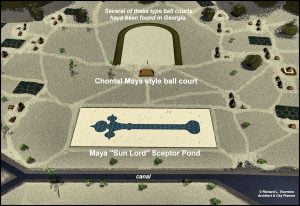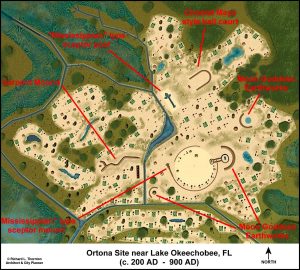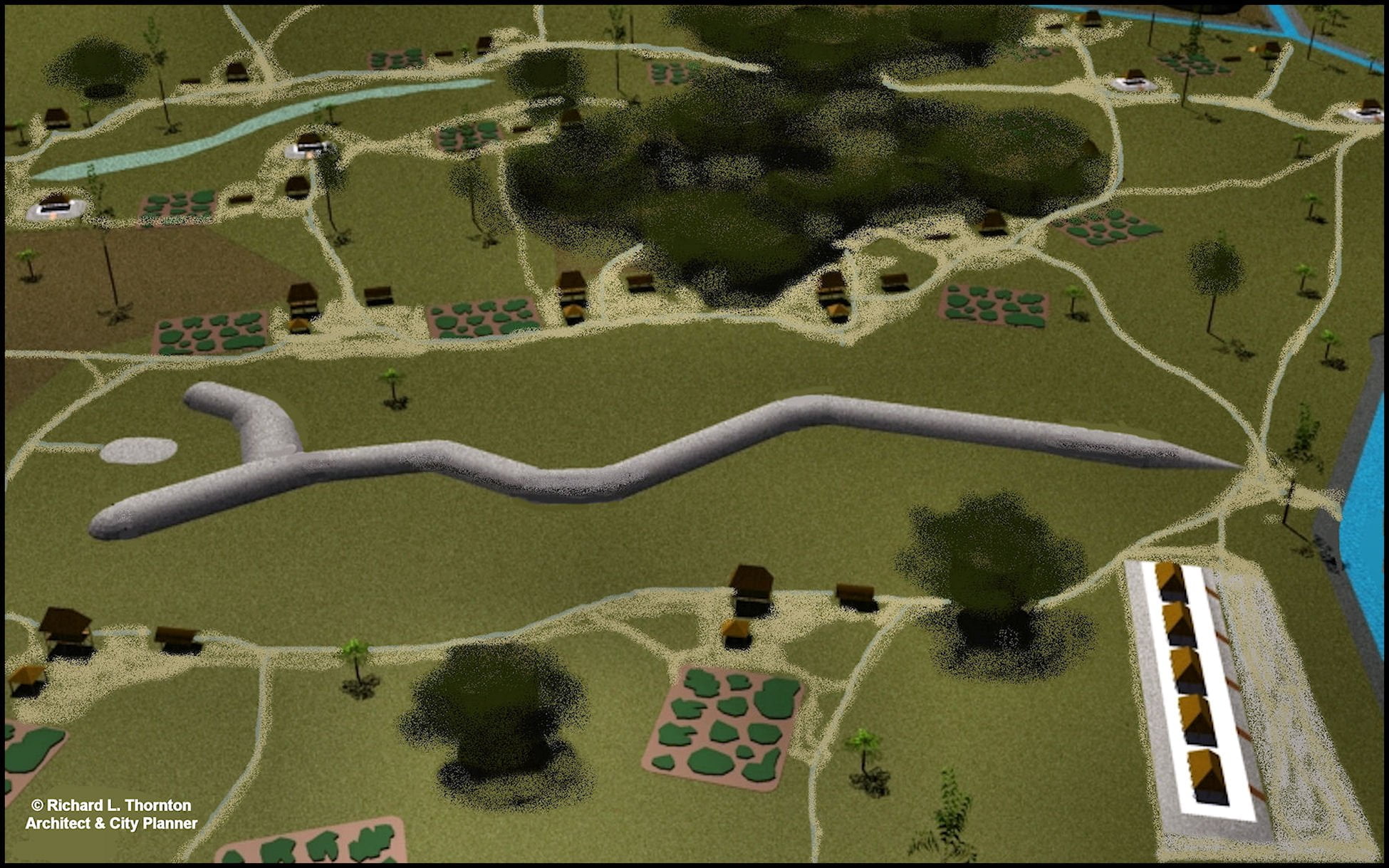Archaeologists working at the Ortona site in the late 1990s and early 2000s were astounded to find “landscaping” in the shape of the scepters carried by the Maya elite in the Yucatan Peninsula. Both a mound and a ceremonial pond were over 100 yards/meters long. 1 The discovery has great significance for the understanding of how cultural ideas traveled around the Caribbean Basin and North America, prior to the arrival of European explorers.
The Scepter Mound – As can be seen in the virtual reality images that accompany this article, there was a complex arrangement of earthworks and buildings in the vicinity of the largest plaza in Ortona. The design and arrangement of the earthworks seem to have symbolic meanings.

A low curvilinear earth berm ran from the Moon Goddess temple to the opposite side of the round plaza. At its end was 450 feet long earth mound in the shape of a typical Maya scepter. These scepters were carried by Hene Ahau’s (Sun Lords.) The Sun Lords were the siblings of the reining Great Sun (king) in a Maya city. An example of this same shape scepter is encircled on a mural from the Maya city of Bonampak. [See photograph of Bonampak mural associated with Part Nine.]
It is not known why the people of Lake Okeechobee would build a super-sized structure in the form of a Maya symbol of authority. The mention by several newspaper articles around the United States of Maya cultural symbols at Ortona that later became Southeastern cultural symbols, provoked hostility by many archaeologists to the Ortona archaeological study. The study received very little publicity in the professional journals and has generally been forgotten by members of the archaeological profession. 2

The Scepter Pond – This unusual 350 feet long pond was located in the northeastern sector of the town of Ortona, immediately west of a horseshoe shaped earthwork. The pond dates from about 700 AD or earlier. Horseshoe shaped earthworks were typical of the Swift Creek Culture towns in the Southeast, but also were used as ball courts in the Chontal Maya towns of Tabasco, Mexico.
The pond was fed by a ditch or small canal leading from a spring. The water then flowed out another channel into one of the major canals of Ortona, which was immediately to the west of the pond. Around the pond was a rectangular plaza created by pouring white sand over crushed shells. There is evidence that the plaza was defined by a fence.
What ceremonial functions did the Scepter Pond have? Archaeologists can only speculate the answer. It is known that both the Creek Indians and their ancestors practiced ritual baptism. Muskogean baptism was not a one time event as in most Christian denominations, but a mandatory prerequisite to attending important religious rituals or political meetings; more similar to early religious practices of the Hebrews. However, it currently is not known whether Ortona’s residents even entered the ceremonial pool.
Spread of scepters to other areas
Beginning around 900 AD at the Ocmulgee acropolis in Macon, GA, and about a century later in many areas of the Southeast and Mississippi River basin, scepters were used by the elite of other peoples to affirm their rank. 3 However, instead of being carved wood staffs with quetzal feather crowns, the Southeastern scepters were made of wood and sheet copper. Stylized copper plate symbolized the feathers on Maya scepters. The shapes of the various scepters became glyphs or abstract symbols of authority in themselves. It is not known whether the indigenous peoples of the Southeast were aware that the original scepter crowns were composed of iridescent green feathers.
At the current time, Lake Okeechobee is the only known region in the Southeast where architecture was created in the form of Maya scepters. 4 It is possible that other towns contained ponds or mounds in the form of the Sun Lord scepters, but that these structures were build during the early occupations of towns
Two Great Serpent Mounds, 864 miles apart
One of the many surprises archaeologists encountered when studying the enormous Ortona Complex was the presence of a very large mound in the form of a snake eating an egg. The initial response of some members of the archaeological profession was that the Ortona Serpent Mound was proof that Hopewell Culture people from Ohio had traveled into the Deep South and catalyzed an advanced culture there. How else could one explain an architectural tradition that Midwestern archaeologists assumed to have originated in the Midwest, have a clone in the southern tip of Florida?
The Great Serpent Mound of Ohio

The Great Serpent Mound of Ohio is also in the form of a coiled snake eating an egg. 5 Archaeologists long assumed that the 1,348-foot (411 m)-long Great Serpent Mound of Ohio was constructed at some time between 1200 BC and 500 AD; by either the Adena or Hopewell Cultures. Many non-professional web sites claim that “it is well known that the Great Serpent Mound dates from 3,000 BC” or that “it is well known that the Great Serpent Mound is 3,000 years old.” 6 7
In 1996, a team of archaeologists, sponsored by the Ohio Historical Society took soil samples from one section of the mound that had been previously excavated. 8 The team determined that “the Great Serpent Mound was built around 1070 AD by the Fort Ancient Culture.” Other archaeologists question where the Fort Ancient Culture has been misidentified. 9 At least two distinct types of “Fort Ancient” communities have been identified. One is a typical layout of the later proto-Chickasaw village with no mounds and no skeletons discovered. The other is a hilltop stone enclosure.
In 2013, a team led by Ohio archaeologist, William Romain, took multiple soil samples from “virgin areas” of the Great Serpent Mound. 10 Some charcoal in soil samples produced radiocarbon dates in the range of 640 BC. Most soil samples produced dates ranging from 381 B.C. to 44 B.C. This would put the structure in the range of the Adena Culture again. However, there are no other Adena effigy mounds and unlike Adena Mounds, the Great Serpent Mound contains almost no artifacts.
The Great Serpent Mound is located near Peebles, in the Hill Country of southern Ohio. The site is well outside the primary Hopewell Cultural Zone, but some Adena villages were occupied in its vicinity. However, the region is better known for its Fort Ancient Culture villages, except that recently, Midwestern archaeologists have reversed themselves and stated that there was no single Fort Ancient Culture. 11 Rather there was a juxtaposition of several ethnic groups in the Ohio Basin.
Until recently the Fort Ancient Culture was defined as beginning around 900-1000 AD as a Late Woodland Period People. 12 Over time, its cultural traits were increasingly similar to those of the Muskogean Mound builders of eastern Tennessee. By 1400 AD, Fort Ancient villages contained oval plazas and rectangular houses like the communities in eastern Tennessee.
In 1996, radiocarbon tests were run on charcoal found at the base of the Great Serpent Mound. 13 One sample was found to be about 2300 years old, while the other two were dated at c. 1070 AD. This date coincides with the early phase of the Fort Ancient Culture. However, at this time the Fort Ancients were not building mounds. The artifacts found near the Serpent Mound are not like those produced by the Fort Ancients.
Another interesting fact is that the Serpent Mound is at the same longitude line as Ocmulgee in Macon, GA. 14 In other words, the Serpent Mound is due north of Ocmulgee. Ocmulgee is not due north of the Ortona Serpent Mound.
The ethnic identities of both the Fort Ancient Culture and the builders of the Great Serpent Mound both remain unknown. The ethnic identity of the peoples of the Adena and Hopewell Cultures are currently subject to intense debates All or most of these cultural phases probably represent different ethnic groups. The symbolic meaning and ritual purposes of Ohio’s Great Serpent Mound remain a matter of conjecture and debate.
The Great Serpent Mound of Florida

Little can be said about the Florida Serpent Mound other than it probably dates from about 500 BC to 900 AD. It had not been studied thoroughly by archeologists. There has never been a comparison of artifacts unearthed near the Ohio Serpent Mound and those discovered near the Florida Serpent Mound. The Florida mound has also not been surveyed. The virtual reality image included with this article is based on a pencil sketch on grid paper by an archaeologist. Being constructed of sandy soil and subject to the erosive effects of hurricanes, its twisting form is not as distinct as the Ohio Serpent Mound. It is probable that residents of Ortona built this mound, but there is insufficient evidence to make this statement with certainty.
Since there is substantial evidence that Ohio’s Serpent Mound was not built by nearby residents, it is always the possibility that Great Serpent Mounds of both states were built by the same people, or at least, the same religious cult.
Citations:
- Miller, Rhonda J. “Ancient Indian Find Thrills Scientists.” Fort Lauderdale Sun-Sentinel, June 7, 2002.[↩]
- Absolutely no information can be found about the ceremonial pond from professional journals or standard printed and online references. All information is from newspaper articles.[↩]
- Thornton, Richard. Ancient Roots III: The Indigenous Peoples and Architecture of the Ocmulgee-Altamaha River Basin. Raleigh: Lulu Publishing. 2008; p. 85.[↩]
- It is highly probable that such ponds exist somewhere in southeastern or central Georgia, but they have not be identified and may now be invisible at the surface because of sediment.[↩]
- Glotzhober and Lepper, “Serpent Mound: Ohio’s Enigmatic Effigy Mound“, Ohio Historical Society, Columbus, Ohio, 1994; p. 11.[↩]
- Scientists try to unlock Serpent Mound secrets … celestial secrets … EYE Report[↩]
- Analysis: The Great Serpent Mound[↩]
- Fletcher, Robert V.; Terry L. Cameron; Bradley T. Lepper; Dee Anne Wymer; William Pickard (Spring 1996). “Serpent Mound: A Fort Ancient Icon?“. Midcontinental Journal of Archaeology (University of Iowa) 21 (1).[↩]
- Kevin C. Nolan and Robert A. Cook. “An evolutionary model of social change in the Middle Ohio Valley.” Columbus, Ohio, Ohio State University; 2009.[↩]
- New Radiocarbon Dates Suggest Serpent Mound is More Than 2,000 Years Old[↩]
- Pollack, David; Henderson, A. Gwynn; Raymer, C. Martin. “Regional Variation in Kentucky Fort Ancient Shell Temper Adoption.” Southeastern Archaeology , Vol. 27, No. 2 , Winter 2008.[↩]
- Pollack, David; Henderson, A. Gwynn; Raymer, C. Martin. “Regional Variation in Kentucky Fort Ancient Shell Temper Adoption.” Southeastern Archaeology , Vol. 27, No. 2 , Winter 2008.[↩]
- Fletcher, Robert V.; Terry L. Cameron; Bradley T. Lepper; Dee Anne Wymer; William Pickard (Spring 1996). “Serpent Mound: A Fort Ancient Icon?“. Midcontinental Journal of Archaeology (University of Iowa) 21 (1).[↩]
- ERSI GIS calculation by author.[↩]
